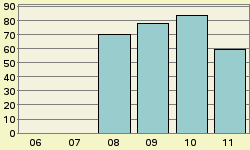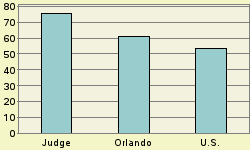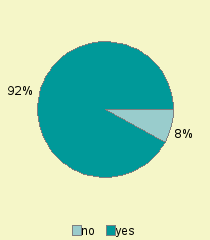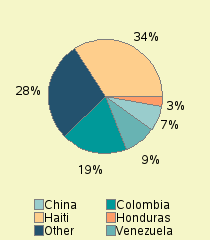Judge Kevin J. Chapman
FY 2006 - 2011, Orlando Immigration Court
Judge Chapman was appointed as an immigration judge in March 2008. He received a bachelor of science degree in 1979 from Arkansas Tech University and a juris doctorate in 1986 from the University of North Carolina, Chapel Hill. From 2003 to March 2008, Judge Chapman served as deputy general counsel, Office of the General Counsel, EOIR. During that time, from July 2006 to March 2008, he was acting general counsel. From 2000 to 2003, he worked as associate general counsel for the U.S.Marshals Service. From 1994 to 2000, Judge Chapman was in the U.S. Army where he served as staff judge advocate, deputy staff judge advocate,and litigation attorney. Judge Chapman is a member of the North Carolina Bar.
Deciding Asylum Cases
Detailed data on Judge Chapman decisions were examined for the period covering fiscal years 2006 through 2011 During this period, Judge Chapman is recorded as deciding 656 asylum claims on their merits. Of these, he granted 152, gave no conditional grants, and denied 497. Converted to percentage terms, Chapman denied 75.8 percent and granted (including conditional grants) 24.2 percent. Figure 1 provides a comparison of Judge Chapman's denial rate fiscal year-by-year over this recent period. (Rates for years with less than 25 decisions are not shown.)
Nationwide Comparisons
Compared to Judge Chapman's denial rate of 75.8 percent, nationally during this same period, immigration court judges denied 53.2 percent of asylum claims. In the Orlando Immigration Court where Judge Chapman was based, judges there denied asylum 61.2 percent of the time. See Figure 2.
Judge Chapman can also be ranked compared to each of the 256 individual immigration judges serving during this period who rendered at least one hundred decisions in a city's immigration court. If judges were ranked from 1 to 256 - where 1 represented the highest denial percent and 256 represented the lowest - Judge Chapman here receives a rank of 69. That is 68 judges denied asylum at higher rates, and 187 denied asylum at the same rate or less often. Ranks are tallied separately for each immigration court. Should a judge serve on more than one court during this period, separate ranks would be assigned in any court that the judge rendered at least 100 asylum decisions in.
Why Do Denial Rates Vary Among Judges?
Denial rates reflect in part the differing composition of cases assigned to different immigration judges. For example, being represented in court and the nationality of the asylum seeker appear to often impact decision outcome. Decisions also appear to reflect in part the personal perspective that the judge brings to the bench.
Representation
If an asylum seeker is not represented by an attorney, almost all (87%) of them are denied asylum. In contrast, a significantly higher proportion of represented asylum seekers are successful. In the case of Judge Chapman, 8.4% were not represented by an attorney. See Figure 3. For the nation as a whole, about 11.1% of asylum seekers are not represented.
Nationality
Asylum seekers are a diverse group. Over one hundred different nationalities had at least one hundred individuals claiming asylum decided during this period. As might be expected, immigration courts located in different parts of the country tend to have proportionately larger shares from some countries than from others. And, given the required legal grounds for a successful asylum claim, asylum seekers from some nations tend to be more successful than others.
For Judge Chapman, the largest group of asylum seekers appearing before him came from Haiti. Individuals from this nation made up 34 % of his caseload. Other nationalities in descending order of frequency appearing before Judge Chapman were: Colombia (18.8 %), Venezuela (9.1%), China (7.2%), Honduras (2.7%). See Figure 4.
In the nation as a whole during this same period, major nationalities of asylum seekers, in descending order of frequency, were China (23.3%), Haiti (8.4%), El Salvador (5.9%), Colombia (5.5%), Guatemala (5.3%), Indonesia (2.9%), India (2.6%), Venezuela (2.5%), Ethiopia (2.1%), Albania (2%), Honduras (2%), Mexico (2%), Guinea (1.6%).




